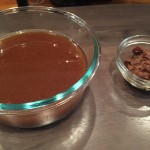
My very first food blog post is my very first favorite food, a Vietnamese dish my mother would make for me growing up in Virginia. Canh Chua directly translates to English as “sour soup” and originates from Southern Vietnam, in the Mekong Delta region. It’s somewhat similar to Thailand’s Tom Yum Soup.
Canh Chua is a soup with a tamarind broth, full of tomatoes, pineapple and bean sprouts. From there, you can personalize it many different ways. Usually, fish, Bac Ha (also called elephant ear stems) and okra is added, served with Jasmine rice. I prefer to add enoki mushrooms and serve over quinoa.
I prepare my fish sous-vide, which preserves the beautiful vibrant orange color of Salmon as well as keeps the texture, moisture and flavor of the fish intact. Sous vide cooking is great for cooking food evenly, ensuring the core is fully cooked without overcooking the exterior. It’s putting your food in a zip-loc baggy and putting it in a food jacuzzi. It’s fun! (If you do not have a sous vide, you can boil your salmon in the broth, but remove promptly after it’s cooked through because the fish will crumble and fall apart into the soup. This is the traditional way to cook Canh Chua, however I find that the salmon loses a lot of its own flavor and dries out this way. I am also in love with my Sansaire, so I may be biased!)
Here’s my step-by-step non-traditional, healthy take on a Vietnamese staple. No sugar, no salt, no chemicals or preservatives!

PREP YO-SELF
Before you start cooking, prep yourself. Tie your hair up in a bun, wash your hands and under your nails, crank up Eric Church and make sure you’re barefoot in the kitchen.
Pour yourself a glass of white wine, it doesn’t matter the time of day.
SALMON PREP
Fill up your container of choice (I use my dutch oven) with water and attach your sous vide machine (Sansaire, in my case). Preheat to 45 degrees Celsius.
Cut the fillet into serving portions, placing each into a separate Zip-Loc bag with 1 tbsp of olive oil. (The oil coats the fish to prevent oxidation if any air is present). Don’t zip up the bags.
Use the Water Displacement Method to “vacuum seal” the fish. Slowly dip one Zip-Loc bag into the water bath, the water self-pushes out the air, then zip the bag. This soft seal keeps the water inside the fish from boiling therefore keeping the fish from getting mushy. Science cooking is cool, guys!
Set the timer for 30 minutes, allow the salmon to enjoy the Jacuzzi.
When the salmon is ready, remove the salmon bags promptly. Take each salmon fillet out of the bag, gingerly, using your hands. Place them all on a plate for later. Admire it’s orange beauty.
 FOOD PREP
FOOD PREP
Place chunk of Tamarind pulp into a medium size bowl and add 2 cups of hot water. Make sure your rings are off, then dig in! Use your hand to massage the tamarind pulp submerged in the water, squeezing the pulp and extracting the goodness into the water. The water will turn brown and the pulp will get smaller and smaller until only seeds and rinds remain. Discard those.




Slice tomatoes. Cut the okra, bac ha diagonally (that’s how the Vietnamese do it). Okra is slimy, don’t get scared. Wash the enoki mushrooms and separate the roots. Chop Cilantro and Rau Ngo Om.
Cook quinoa according to instructions. Keep to the side.
Arrange your mise en place and clean up everything- cutting board, knives, trash, work space. It is so important to have a clean work zone.

SOUP TIME
Pour the 2 pineapple cans with all the juices into the dutch oven. Add water until the pot is about 2/3 full. Add tomatoes, bac ha and okra. Add ½ cup fish sauce, 2 cups tamarind juice. Stir. Bring to a boil (using a dutch oven, this takes about 30 minutes so keep stirring and taste testing).
Add enoki mushrooms. Stir. Add additional fish sauce, tamarind juice to taste if needed. I prefer my soup really sour, but everyone is different! Right before serving, dunk in one small handful of bean sprouts per plate into boiling soup. Once they are soft, serve immediately.
PLATING
Use a large white bowl, place 1 cup of quinoa and cover with soup. Place one salmon fillet on top, sprinkle with a little Maldon sea salt. Garnish with Rau Ngo Om and Cilantro. Pour another glass of wine. Bon appétit!


NOTES:
- If your pot runneth over (too full), just scoop out some of the soup with veggies (even amount of each) into a separate bowl. Then add the bean sprouts. Once you plate a few bowls, you can return that spare bowl into the pot.
- Keep the bean sprouts to the side and only add as you are about to serve. If you’re lazy, add them all at once but they get really soggy if you don’t mind!
- If the taste of the quinoa is too overwhelming and you are used to the white rice accompaniment, stick to it like white on rice! (sorry, too easy)
- If you would like your salmon cooked more well done, cook at 50 degrees C sous vide.
- Add spiciness with some chopped peppers.


- 1 lb wild-caught salmon
- EVOO
- 5 tomatoes on the vine, sliced
- 2 20 oz. cans of Dole Pineapple Chunks in 100% pineapple juice
- 1/8 Tamarind pulp from 16 oz packet (Me Chua)
- 2 cups hot water
- 2 packages Enoki mushrooms, washed, roots separated
- 5 12 inch stems of Bac Ha, sliced
- Small bundle of Rau Ngo Om, chopped
- 1 cup of American okra, sliced
- 1 bag of Bean sprouts
- ½ cup Squid brand Fish Sauce
- White organic quinoa
- Cilantro, chopped
- Preheat Sansaire sous vide water bath to 45 degrees Celsius.
- Cut salmon into serving portions, placing each into a separate Zip-Loc bag with 1 tbsp of olive oil.
- Use the Water Displacement Method to “vacuum seal” the fish. Slowly dip one Zip-Loc bag into the water bath, the water self-pushes out the air, then zip the bag.
- After 30 minutes, remove the salmon bags. Take each salmon fillet out gingerly, using hands. Place on a plate for later.
- Cook according to instructions. Keep to the side.
- Place chunk of Tamarind pulp into a medium size bowl and add 2 cups of hot water. Hand massage the tamarind pulp submerged in the water, squeezing the pulp until juice turns brown. Discard seeds and rind.
- Slice tomatoes. Cut the okra and bac ha diagonally. Wash the enoki mushrooms and separate the roots. Chop Cilantro and Rau Ngo Om.
- Pour the 2 pineapple cans with all the juices into a 5.5L dutch oven. Add water until the pot is about 2/3 full. Add tomatoes, bac ha, okra, fish sauce, tamarind juice. Stir. Bring to a boil (using a dutch oven, this takes about 30 minutes so keep stirring and taste testing).
- Add enoki mushrooms and bean sprouts. Once they are soft, serve immediately.
- Use a large white bowl, place 1 cup of quinoa and cover with soup. Place one salmon fillet on top, sprinkle with a little Maldon sea salt. Garnish with Rau Ngo Om and Cilantro.
- Keep the bean sprouts to the side and only add as you are about to serve.
- For well-done salmon, cook at 50 degrees C sous vide.
- If you do not have a sous vide, you can boil your salmon in the broth, but remove promptly after it’s cooked through because the fish will crumble and fall apart into the soup. This is the traditional way to cook Canh Chua.
- Add spiciness with some chopped peppers.







